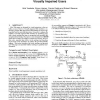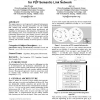WWW
2004
ACM
15 years 1 months ago
2004
ACM
The use of semantic web languages brings a number of advantages for web engineering methodologies. In this paper we present how in the Hera methodology the design models benefit f...
WWW
2004
ACM
15 years 1 months ago
2004
ACM
WWW
2004
ACM
15 years 1 months ago
2004
ACM
The wealth of information available on the web makes it an attractive resource for seeking quick answers. While web-based question answering becomes an emerging topic in recent ye...
WWW
2004
ACM
15 years 1 months ago
2004
ACM
An important obstacle to the success of the Semantic Web is that the establishment of the semantic relationship is labor-intensive. This paper proposes an automatic semantic relat...
WWW
2004
ACM
15 years 1 months ago
2004
ACM
Existing commercial Web browsers provide various utilities and functions, e.g., Web bookmarks and a browsing history list. Since the bookmark and history functions only the title ...
WWW
2004
ACM
15 years 1 months ago
2004
ACM
This paper proposes a novel approach to integrate heterogeneous data in P2P networks. The approach includes a tool for building P2P semantic link networks, mechanisms for peer sch...
WWW
2004
ACM
15 years 1 months ago
2004
ACM
Search results generated by searchable databases are served dynamically and far larger than the static documents on the Web. These results pages have been referred to as the Deep ...
WWW
2004
ACM
15 years 1 months ago
2004
ACM
An active e-course is a self-representable and self-organizable document mechanism with a flexible structure. The kernel of the active e-course is to organize learning materials i...
WWW
2004
ACM
15 years 1 months ago
2004
ACM
In many Web search applications, similarities between objects of one type (say, queries) can be affected by the similarities between their interrelated objects of another type (sa...
WWW
2004
ACM
15 years 1 months ago
2004
ACM
On-demand broadcast has been supported in the Internet to enhance system scalability. Unfortunately, most of existing on-demand scheduling algorithms did not consider the time con...





